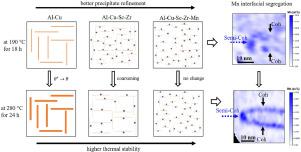Acta Materialia ( IF 8.3 ) Pub Date : 2021-01-08 , DOI: 10.1016/j.actamat.2021.116634 Lu Jiang , Baptiste Rouxel , Timothy Langan , Thomas Dorin

|
The refinement and thermal stability of intermediate theta-prime () precipitates are critical in the development of new high strength 2xxx series aluminium-copper (Al-Cu) alloys for high temperature applications. In this work, we use trace additions of Sc, Zr and Mn in an Al-6.5 wt.% Cu alloy to refine and stabilise the precipitates. The formation of Al3(Sc, Zr) core/shell dispersoids significantly refine the precipitates by acting as preferential nucleation sites during artificial ageing. Adding Mn results in a significant increase of hardness during ageing at 190 °C. Hardness is maintained during thermal exposure at 280 °C for up to 24 h. Transmission electron microscopy (TEM) reveals that the addition of Mn leads to a finer and denser distribution of precipitates, and greatly slows the growth and coarsening of the precipitates at elevated temperatures. Differential scanning calorimetry (DSC) shows that this can be attributed to an enhanced nucleation and improved coarsening resistance of the precipitates in the presence of Mn. Atom probe tomography (APT) reveals that the enhanced age-hardening kinetics and thermal stability arise from the independent segregation mechanisms of Mn, Sc and Zr at the semi-coherent and coherent interfaces of the precipitates. The segregation is quantified by calculating the Gibbsian interfacial excess and corresponding reduction in interfacial energy. These calculations reveal that while Sc and Zr play a significant role in the refinement of the precipitates, Mn not only refines the precipitates, but also greatly enhances their coarsening resistance and corresponding alloy's thermal stability.
中文翻译:

Sc,Zr和Mn的耦合偏析机理 界面增强了Al-Cu合金的强度和热稳定性
中间theta-prime()沉淀对于开发用于高温应用的新型高强度2xxx系列铝铜(Al-Cu)合金至关重要。在这项工作中,我们在Al-6.5 wt%的Cu合金中使用痕量的Sc,Zr和Mn来精炼和稳定合金。沉淀。Al 3(Sc,Zr)核/壳弥散体的形成显着改善了通过在人工时效过程中充当优先成核位点而沉淀出来。添加Mn会导致190°C时效时硬度显着增加。在280°C的温度下暴露长达24小时,可以保持硬度。透射电子显微镜(TEM)显示,Mn的添加会导致Mn的分布更细密。 沉淀,大大减慢了合金的生长和粗化 在高温下沉淀。差示扫描量热法(DSC)表明,这可以归因于增强的成核作用和改善的耐粗化性。在Mn存在下沉淀。原子探针层析成像(APT)表明,增强的时效硬化动力学和热稳定性来自Mn,Sc和Zr在合金半相干和相干界面处的独立偏析机理。沉淀。通过计算吉布斯界面过量和界面能的相应减少来量化偏析。这些计算表明,尽管Sc和Zr在精炼合金中起着重要作用。 沉淀,Mn不仅可以提炼 沉淀,但也大大提高了它们的耐粗化性和相应合金的热稳定性。











































 京公网安备 11010802027423号
京公网安备 11010802027423号